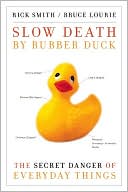Principles of Exposure Measurement in Epidemiology: Collecting, Evaluating, and Improving Measures of Disease Risk Factors
The second edition of this internationally acclaimed title is the ideal handbook for those involved in conducting epidemiological research. The objective of most epidemiological studies is to relate exposure to putative causal agents to the occurrence of a particular disease. The achievement of this objective depends critically on accurate measurement of exposure. This book reviews principles and techniques that can be applied to measuring a wide range of exposures, including demographic,...
Search in google:
The second edition of this internationally acclaimed title is the ideal handbook for those involved in conducting epidemiological research. The objective of most epidemiological studies is to relate exposure to putative causal agents to the occurrence of a particular disease. The achievement of this objective depends critically on accurate measurement of exposure. This book reviews principles and techniques that can be applied to measuring a wide range of exposures, including demographic, behavioral, medical, genetic, and environmental factors. The book covers questionnaire design, conducting personal interviews, abstracting information from medical records, use of proxy respondents, and ascertaining biological and environmental measurements. It gives a comprehensive account of measurement error and the estimation of its effects, and the design, analysis, and interpretation of validity and reliability studies. Emphasis is given to the ways in which the validity of measurements can be increased. Techniques to maximize participation of subjects in epidemiological studies are discussed, and ethical issues relevant to exposure measurement are outlined.
Preface vExposure measurement 1Introduction 1Exposure 3Measurement and scales of measurement 9Exposure dose 11Timing of exposure 17Items to measure in a study 25The measurement instrument 29Summary 30About this book 32References 34Methods of exposure measurement 37Introduction 37Classification of exposures 37Methods overview 39Choice of method 47Choosing method of administration of questionnaires: face-to-face, telephone or self-administered 52Summary 60References 61Exposure measurement error and its effects 65Introduction 65Continuous exposure measures 67Categorical exposure measures 83Effect of measurement error in the presence of covariates 91Summary 92References 93Validity and reliability studies 97Introduction 97The interpretation of measuresof reliability 98Issues in the design of validity and reliability studies 112Analysis of validity and reliability studies 117Summary 137References 138Reducing measurement error and its effects 141Introduction 141Adjustment of study results for the effects of measurement error 142Use of scores or averages based on multiple measures of exposure 146Other methods to reduce measurement error 154Quality control procedures 158Summary 170References 171The design of questionnaires 175Introduction 175Choice of items to be covered 176Types of question 178Question content 181Question wording 182Question order 190Questionnaire structure 192Questionnaire format 195Asking about behaviours that vary over time 199Aids to recall 200Pre-testing questionnaires 202Translating questionnaires 208Summary 209References 210The personal interview 213Introduction 213Interviewer error 214Types and styles of interview 217The optimal circumstances for an interview 218The interviewer's task 219Selection, training, and supervision of interviewers 227Special aspects of telephone interviewing 233Summary 235References 236Use of records, diaries, and proxy respondents 239Introduction 239Use of records 239Use of diaries 254Use of proxy respondents 266References 275Measurements in the human body or its products 285Introduction 285The value and limitations of measurements in the human organism 287Measurement of xenobiotic compounds 291Measurement of endobiotic compounds 301Quality control in biological measurements 308Banks of biological specimen 315Summary 318References 320Measurements in the environment 325Introduction 325The value and limitations of environmental measurements 326Sampling and measuring present exposures 329Sampling and measuring past exposures 339Summary 352References 353Response rates and their maximization 357Introduction 357Calculating response rates and other participation rates 358Factors associated with non-response 360Selection bias 364Maximization of response rates 367Summary 391References 392Ethical issues 401Introduction 401Human rights and epidemiological research 402Ethical practice in epidemiological research 407Summary 419References 420Index 423








